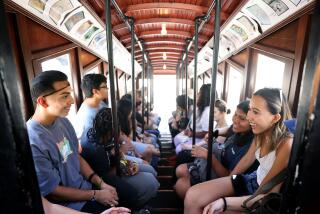HANDS ACROSS THE BORDER : As ‘Carpenters of the Cross,’ teen-agers build a cultural bridge by constructing houses for poor families during 5-day mission in barrio of Tijuana
TIJUANA — The smell of raw sewage greeted the 100 Americans almost as soon as their caravan of motor homes turned off the main highway and wheezed up the tortuous unpaved roads of one of this city’s poorest barrios.
Passing by small cinder block houses and plywood shacks--many without electricity, nearly all without running water--they finally reached the center of Colonia Lazaro Cardenas, a dusty settlement of several thousand homes perched atop garbage-strewn hills.
But the mostly teen-age visitors who came here last week from Presbyterian churches in Camarillo and Oxnard did not seem disheartened about spending their Easter vacations amid such bleak surroundings.
With the ambitious goal of building seven small houses during their annual five-day mission, these “Carpenters of the Cross” hoped to make as great an impact on the destitute barrio as life in the barrio would make on them.
‘They Show So Much Gratitude’
“It’s just a small change, but they show so much gratitude,” said Karen Giles, 16, of Camarillo’s Trinity Presbyterian Church. “Sometimes we forget how lucky we really are.”
Even with their good intentions, however, the presence of so many Anglo middle-class high school students was not without its awkward moments, especially in a place reminded of its relationship with the United States by patrolling helicopters crisscrossing the horizon.
Some of the girls, for instance, complained about the local men, who at times responded to the novelty of American visitors with whistles and lewd jeers.
Other teen-agers, after a hot morning working on one of the wooden one-room homes, found themselves clumsily refusing an offer of homemade punch--presumably made with unpurified water--from the family that would soon be living there.
And a few saw a disturbing symbolism when leaders of the Camarillo group, which camped and ate its meals in an outdoor courtyard in the colonia, or neighborhood, announced that they would keep the iron gate surrounding them shut at all times for security reasons.
“It was kind of like the border,” said 16-year-old Michele Swaner of Camarillo. “We could come and go freely, but they couldn’t come to us. . . . Like, we have all this, and you can’t have any of it.”
Church leaders readily acknowledged the difficulty of trying to bridge the many gaps that separated them from the colonia’s residents, but said the value of their efforts far outweighed any harm that might have been done by cultural gaffes.
“We have to try to reach out, knowing that we’re going to make mistakes, that we’re going to say and do things that are not as sensitive as we want them to be,” said Chris Kohlbry, 33, associate pastor of Trinity Presbyterian. “We need to take that risk. . . . It’s worth failing.”
For seven Mexican families who were able to trade in miserable dirt-floor huts for simple but sturdy 12-by-16-foot houses, there was no question but that it had been a worthy venture.
“This means so much to me,” said Antonina Rivera, 42, who, along with three of her children, had just been evicted from a rented house. “I feel rich now.”
And for the dozens of teen-agers, many of whom ended their stay in tearful exchanges with the residents of their new homes, there was also little doubt that at least some gaps had been bridged.
“We have so much richness over there,” said 19-year-old Adriane Hopkins of Oxnard’s First Presbyterian Church, as she gestured to the north. “But they have a richness here, too. They don’t feel sorry for themselves.”
Ties Since 1967
Although this was one of the largest delegations to visit the colonia in recent years, church groups from California have had ties with the barrio since 1967, when a Presbyterian minister from Whittier named James Letcher founded a community center there known as Futuro del Oro, or “Future of Gold.”
As word of the center circulated among church leaders, contributions flowed in, and soon Futuro was offering medical services, kindergarten classes and a scholarship program for teen-age students.
But it wasn’t until 1980, when a San Gabriel Valley minister and his youth group arrived at the center to build a single plywood house, that droves of young volunteers began making the journey with the idea of leaving behind more permanent contributions.
Since then, about 100 houses have been constructed here by more than a dozen California churches, which, besides the Ventura County groups, include La Habra Hills Presbyterian Church, St. Peter’s by the Sea Presbyterian Church in Palos Verdes and Village Presbyterian Church in Arcadia. The structures, which consist of wooden beams and plywood walls mounted on a cement foundation, cost the churches about $800 each in materials.
“They’re not just writing out a check for some far-off need; they’re getting their hands dirty,” said Ethel Walton, 71, an El Monte electrician, who serves as president of the Futuro del Oro board of directors. “They’re not rich gringos looking down on the poverty; they’re friends.”
Waking at sunrise every morning, the groups formed into construction crews of eight youths and two adult advisers, some of whom wore custom T-shirts that in Spanish spelled out their religious mission as “Carpinteros de la Cruz.”
Although few of the teen-agers had any expertise in carpentry, they quickly grasped the concept of the box-like homes, which required them to hammer 2-by-4s into four rectangular frames, saw sheets of wood to span them, and drill holes in the bottom so that they could be mounted as walls onto steel rods in the ground.
Often the structures were built next to the shoddy huts they were replacing. At least one member of the families receiving a new house usually helped with the construction and was asked where the doors and windows should go.
“I never imagined that Americans would come like this to help the Mexicans,” said Rosa Ramirez de Garcia, 26, as she watched her new house rise next to the shack where she had lived for the last year with her husband and four children. “If it weren’t for them, we wouldn’t have anything.”
Don Lupe Chooses
In order to qualify for one of the houses, residents of the colonia must file an application with Jose Guadalupe Juarez, a husky, good-humored man known affectionately as Don Lupe, who for the last several years has been the principal contact for the church groups.
Juarez, a custodian at a religious school in a neighboring barrio, said he assigns priority to the most needy families, a judgment that he makes based on the number of children, the family’s income and whether the money goes toward nutrition or drink.
“I observe and I analyze,” said Juarez, 38, estimating that as many as 20 families are on his waiting list at any one time. “How much do they earn, and how do they spend it? . . . Does the husband buy food or liquor? . . . Where is the need?”
To be accepted, applicants must also demonstrate that they own the land where the house is to be constructed and sign a contract specifying that, if the land is ever sold, the house must be passed on free of charge to the buyer.
The rules, however, although designed to screen out opportunistic landlords, also disqualify some of the neediest squatter families, whose meager resources force them to live on other people’s land in extreme impoverishment.
Pedro Barron, for example, lives with his wife, a friend and three children in a 3-foot-high, doghouse-like hut on the side of a ravine known as El Hoyo, “the Hole.”
Although they applied to Futuro for a house almost as soon as they migrated to the colonia last summer from the central Mexican state of Guanajuato, they do not qualify for aid because they have no land on which the church groups can build.
“We can hardly sleep at night,” said Barron’s 28-year-old wife, Vicenta, one morning after high winds had almost blown down their flimsy cardboard and plywood hut. “What can we do?”
Despite such cases, Juarez said, the housing program provokes little resentment among the colonia’s population, rapidly expanding because of economic refugees from Mexico’s interior who are trying to capitalize on Tijuana’s industrial boom.
“They’re accustomed to the fact that some people have more than they do,” he said. “They come here, and they’re poor, but at least there’s work. Little by little, they move their way up.”
Poverty a Jolt
The colonia, about 7 miles southwest of the city’s brassy central strip and so close to the United States that downtown San Diego can be seen gleaming in the distance, offered its teen-age visitors a jolting introduction to a kind of poverty rarely encountered north of the border.
The 40 members of the Oxnard group opted to stay at a campground near Rosarito Beach, but the 60-member Camarillo contingent slept in the cement courtyard of the Futuro del Oro center, where belching buses, cockroaches, pockmarked streets and a pungent outhouse made it impossible to mistake their surroundings for Ventura County’s Gold Coast.
At first the youths struggled to adjust to neighbors staring from the yards of their ramshackle houses, the garbage dumped down the numerous ravines and the exploding population of flies that seem to permeate all of the colonia.
“It was kind of shocking,” confided one girl on the first evening. “We sort of look at this as a camping trip, but people live like this year-round.”
As their mission neared completion, however, the surroundings began to look more familiar. Hours of hammering and sawing with the Mexican families began to yield friendships, even for the many youths who spoke no Spanish.
And finally, on the last night, the entire group let off steam with a high-spirited dinner and dance attended by a dozen or so Mexican teen-agers who had received scholarships through the Futuro program.
“There’s always a lot of good stories,” said Eric Young, 21, of Camarillo, who was on his second trip to the colonia. “Some you can share, but others we have to just keep inside.”
In the end, the exhausted crews finished the construction on schedule and, after holding hands in prayer at each site, headed back last Thursday to a warm welcome from their congregations.
Left behind were seven brightly painted homes, which stand out against the quiet earth tones of the barrio as lasting reminders of their visit.
More to Read
Sign up for Essential California
The most important California stories and recommendations in your inbox every morning.
You may occasionally receive promotional content from the Los Angeles Times.









